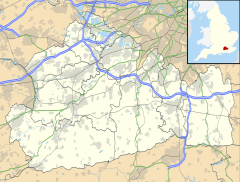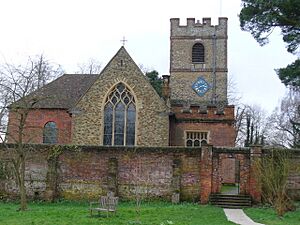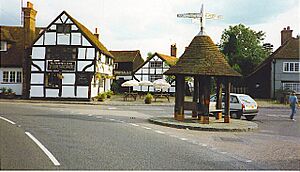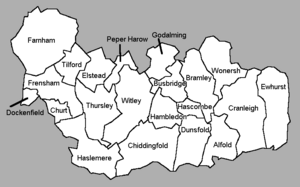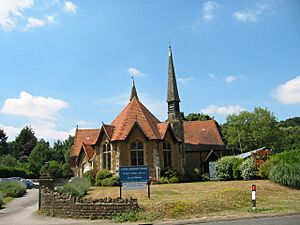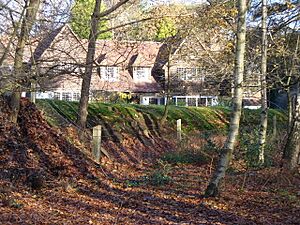Wonersh facts for kids
Quick facts for kids Wonersh |
|
|---|---|
| Village and civil parish | |
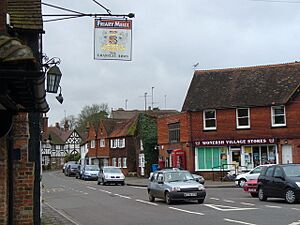 Wonersh Village Stores and The Street |
|
 Part of the village and Surrey Hills AONB |
|
| Area | 17.18 km2 (6.63 sq mi) |
| Population | 3,412 (Civil Parish 2011) |
| • Density | 199/km2 (520/sq mi) |
| OS grid reference | TQ016453 |
| Civil parish |
|
| District | |
| Shire county | |
| Region | |
| Country | England |
| Sovereign state | United Kingdom |
| Post town | Guildford |
| Postcode district | GU5 |
| Dialling code | 01483 |
| Police | Surrey |
| Fire | Surrey |
| Ambulance | South East Coast |
| EU Parliament | South East England |
| UK Parliament | |
Wonersh is a lovely village and civil parish in the Waverley area of Surrey, England. It's also part of the beautiful Surrey Hills Area of Outstanding Natural Beauty. Wonersh has three special 'Conservation Areas' that protect its historic charm. It stretches about 3 to 6 miles southeast of Guildford.
The village is about 28 miles southwest of London, making it a part of the London commuter belt. Most of the jobs in Wonersh are in the service industry, like shops and offices. You can find three historic churches here, along with many interesting old homes. One of these is a grand mansion built in 1905, which is now a hotel and a popular place for weddings.
Contents
What's in a Name?
The name Wonersh has changed over many years! Old records show it as Wonherche in the 1300s, and later as Ognersh or Ignersh in the 1500s and 1600s. The name Woghenersh from 1305 gives us a clue. It comes from an old English phrase, (aet) wogan ersce, which means 'at the crooked field'.
A Look Back in Time
Early Days
Even before the Romans came to Britain, people lived in this area! Tools made of flint from the Mesolithic (Middle Stone Age) period have been found in the Blackheath area and near Chinthurst Hill.
Medieval Times
The main church in Wonersh village has very old foundations. This tells us that a settlement has been here since Anglo-Saxon times.
Wonersh itself isn't mentioned in the Domesday Book from 1086. However, six large estates, called manors, were later built on land that was then part of nearby Bramley and Shalford. These manors included Great Tangley, Little Tangley, Halldish, Losterford, Rowleys, and Chinthurst. Great Tangley Manor became a famous home in 1582.
The church in Wonersh used to be a smaller chapel connected to Shalford. The right to choose the vicar (the church leader) was first held by the King, then by a church in London, and later by noble families. In the 1800s, the local lord of the manor bought this right.
After the Renaissance
For a long time, Wonersh had special funds to help its poor people. For example, in 1620, John Austen left money for the poor. Later, in 1672, Henry Chennell left land to help send six poor boys to school. Another person, Mr. Gwynne, gave land and money in 1698 to send four poor boys to school and to give bread to fifteen poor people every Sunday.
From the 1700s to the 1900s, during the Industrial Revolution, the big manor estates became less important. Most of their farmland was sold because it wasn't profitable enough.
Wonersh was once a busy center for making clothes in West Surrey. They were especially known for making blue cloth, likely dyed with a plant called woad.
Wonersh Park was a large, lightly wooded area that is now a public green space near the church. A small stream runs through it, and its 17th-century stone gatehouse is home to a protected type of bat. The original Wonersh Park mansion, built in the 1600s, was taken down in 1935.
In 1848, the Cranleigh Waters river was used to transport coal, building materials, and farm goods as part of the Wey and Arun Canal. This canal helped the village's economy. Northbrook's mill was a 'fulling mill', which means it was used to prepare leather for things like saddles and bags.
In 1905, Frank Cook, the grandson of the famous Thomas Cook (who started the travel company), built a grand mansion called Barnett Hill. He spent a lot of money on it! Later, the Red Cross owned it until 2006. Today, it's a hotel and a place for conferences and events.
Where is Wonersh?
Wonersh village is nestled between two round hills: Chinthurst Hill (121 meters high) to the northwest and Barnett Hill (112 meters high) to the east. The village center itself is about 40 to 50 meters above sea level.
Most of the pine forests and heathland of Blackheath are part of Wonersh. Other small areas or neighborhoods within the parish include Shamley Green, Ridgebridge Hill, Whipley, Plonk's Hill, Woodhill, Lordshill Common, and Norley Common.
The village is about 3 to 6 miles southeast of Guildford and 28 miles southwest of London.
In the south, you'll find grassy areas like Smithwood Common and Wonersh Common in the north. Over 2000 acres of the southeast is covered by Winterfold Wood and Heath, an ancient forest. Parts of this forest are looked after by the Surrey Wildlife Trust.
Hills and Soil
The land in Wonersh rises from west to east. The lower areas are near the Cranleigh Waters river, and the higher ground is part of the Greensand Ridge, which has flint, clay, and sandy soil. The lowest point is about 39 meters above sea level near the Bramley/Wonersh bridge, and the highest is 207 meters at the car park on Winterfold Hill.
The soil in most of Wonersh is a bit heavy and clayey, but it's good for plants. However, the higher areas like Blackheath have sandy soil that drains easily.
 |
Shalford | Shalford | Albury |  |
| Bramley | across Farley Heath and Blackheath Farley Green |
|||
| Bramley | Cranleigh | across Winterfold Heath Ewhurst |
People and Homes
In 2011, the civil parish of Wonersh had 3,412 people living in 1,375 homes.
- Most homes (752) were detached houses.
- There were 423 semi-detached homes.
- 105 homes were terraced houses.
- 87 were flats or apartments.
- Only 8 were caravans or mobile homes.
About 48.7% of households owned their homes outright, meaning they had paid off their mortgages. Another 33.8% owned their homes with a loan. This is higher than the average for the wider region, showing that many people in Wonersh own their homes.
In 2001, about 19.8% of the people in Wonersh were over 65 years old. Most adults were working, with only a small number unemployed. Many women worked part-time.
The economy in Wonersh is mostly about services. This means people work in jobs like retail, healthcare, or education, rather than in factories or farming.
Community Life
Many clubs and groups in Wonersh and Shamley Green are run by the community itself. These include drama groups and sports clubs. The village associations and the Wonersh Parish Council help organize events and look after places like cricket grounds and paths. Shamley Green has two village halls for events.
Sports and Fun
Wonersh village green is a popular spot where local teams play football, cricket, and stoolball. The sports club has a pavilion there with a bar, meeting room, and changing rooms.
The Wonersh Bowling Club is right in the heart of the village. It was started in 1925. The club has six bowling lanes and a pavilion with a kitchen and bar. The bowling season runs from April to September.
Clubs and Societies
The Wonersh Players are a well-known amateur drama group. They write, produce, and perform their own pantomimes. They've been around since 1982 and usually perform at the Wonersh Memorial Hall in February.
The Wonersh History Society was formed in 1993 to keep and share historical information about the area.
There's also the Wonersh Village Club, which is over 110 years old. It's a place where people can play snooker, billiards, darts, and card games.
You can also find an active Wonersh U3A (University of the Third Age) and a Gardening Club.
Around Wonersh
Wonersh is located in a dip between two steep hills: Chinthurst Hill and Barnett Hill. Chinthurst Hill has wooded paths and land managed by the Surrey Wildlife Trust.
The Church of England church, called St John the Baptist, is in a meadow by a stream. It has parts dating back to the 12th century!
There's also a United Reformed church that looks over the village common. A large college, St John's Seminary, was built in 1891 to train Roman Catholic priests. It's built in a grand Italian Renaissance style.
Wonersh has a village shop and post office, which is owned by the community. There's also a small art gallery next door. A scout group helps young people in the village. The Grantley Arms is the main pub and restaurant, often used for events. Both the shop and the pub are in the village center, near a small shelter called the pepper pot.
The local doctor's surgery is across from the post office. It was built in 1972 and made bigger in 1982.
Blackheath
Blackheath is often called Blackheath Village to avoid confusion with the Blackheath in London. It's mentioned in the Domesday Book as Blacheatfeld. Blackheath was once a 'hundred', which was an old administrative area where local leaders would meet.
Blackheath is known for its Victorian-era homes and some early Arts and Crafts buildings designed by Harrison Townsend. Its church, St Martin's, built in 1893, has amazing stained glass and murals by the American artist Anna Lea Merritt.
Shamley Green
Shamley Green is another village within the Surrey Hills Area of Outstanding Natural Beauty. It's located between Wonersh and Cranleigh.
The parish church of Christ Church in Shamley Green was finished in 1864. The churchyard is the resting place of the famous TV artist, Tony Hart, who lived in the village for over 40 years.
Shamley Green has two public green spaces, including the Cricket Green, which sometimes hosts summer fairs. There are also two pubs, The Red Lion and the Bricklayers Arms, and several shops and schools. Shamley Green has many historic buildings, with 22 of them being 'listed buildings' (meaning they are protected for their historical importance).
In 2013, the BBC Two show Horizon featured Shamley Green. They said it had the highest number of cats per person in the United Kingdom!
Winterfold Forest
This forested area in the southeast is next to Winterfold Forest. In the middle of it is Willingshurst House, an Arts and Crafts property built in 1887 by Philip Webb. South of the main forest, there are 11 woodland lakes, one big enough for boats, which are used for fishing and walks.
Important Places to See
The Wonersh Conservation Area has 27 listed buildings, many from the early and late Tudor period. However, none of these are in the highest Grade I category. Just north of the village center, though, is the only Grade I listed building: the moated Great Tangley Manor.
The Dower House
The Dower House is a beautiful building with a Grade II*-listing. Most of its outside was built around 1710. It's made of red brick with a plain tiled roof and many windows. Its style is typical of Queen Anne style architecture.
Wonersh Court
At the other end of The Street, behind a large archway, are eight townhouses called Wonersh Court. These used to be the stables and parade ring for the old Wonersh Park mansion. They were converted into homes between 1745 and 1759. The building is Grade II-listed.
Great Tangley Manor
This manor has a very old core from the 15th century, but its main part was built in 1584. It was later restored and extended by famous architects.
Great Tangley Manor is surrounded by a narrow square moat and is very well preserved. It has been featured in many paintings. A long entrance tunnel crosses the moat. This medieval and Elizabethan building is Grade I listed and has lovely Victorian gardens.
Barnett Hill
Barnett Hill is a Grade II*-listed building. It was designed by Arnold Mitchell in an expensive and fancy Carolean style. It has purple/brown bricks with red brick and yellow stone decorations. The building has three floors and a long service wing.
Christ Church, Shamley Green
Christ Church is a Grade II listed building in Shamley Green. As mentioned before, the churchyard is where TV presenter Tony Hart is buried.
St Martin's Church Blackheath
St Martin's Church in Blackheath is Grade II-listed and is the only listed building there. It has colorful stained glass and impressive arches. The murals inside were painted by the American artist Anna Lea Merritt.
Chinthurst Hill
A tall, decorative tower (called a folly tower) from the 1930s sits on top of Chinthurst Hill, which is 121 meters above sea level. The Surrey Wildlife Trust looks after the hill's woodland and the tower. It's the 31st highest hill in Surrey.
Getting Around
The main road through Wonersh is the B2128. This road connects the village to Shamley Green, Cranleigh, and Guildford. The closest train station is Shalford railway station, which is on the line that goes from Reading to Gatwick Airport via Guildford.
Schools in the Area
- Wonersh Preschool
- Wonersh and Shamley Green C of E Primary School
- Longacre School (an independent school for ages 2–11)
Famous People from Wonersh
- William Howard Seth-Smith III (1852–1928), an architect, was born in Tangley.
- Tony Hart (1925–2009), a famous artist and TV presenter, lived in Shamley Green for over 40 years.
- The Irish actor Max Adrian passed away in Shamley Green in 1973.


